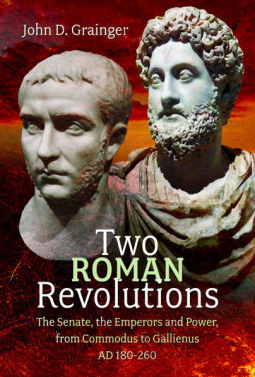
Two Roman Revolutions
The Senate, the Emperors and Power, from Commodus to Gallienus (AD 180-260)
by John D Grainger
This title was previously available on NetGalley and is now archived.
Send NetGalley books directly to your Kindle or Kindle app
1
To read on a Kindle or Kindle app, please add kindle@netgalley.com as an approved email address to receive files in your Amazon account. Click here for step-by-step instructions.
2
Also find your Kindle email address within your Amazon account, and enter it here.
Pub Date Feb 28 2024 | Archive Date Mar 07 2024
Pen & Sword | Pen & Sword Military
Talking about this book? Use #TwoRomanRevolutions #NetGalley. More hashtag tips!
Description
The disastrous reign of the Emperor Commodus, which saw a great expansion of the power of the emperor, eventually resulted in his assassination, but also in a civil war, which was as revolutionary as that of 69. Though the original assassination had been in the name of a restoration of the authority of the Senate - the programme of Pertinax and his supporters - the victory of Septimius Severus established a murderous autocracy, which degenerated into incompetence under his successors. It also set up a continuous tension within the government between imperial and senatorial powers and authority.
The weakness of the imperial power after Caracalla was emphasised by the assassination of all emperors between 217 and 238; it also produced an increase in warfare on all frontiers from Syria to Britannia. In the later years of Alexander Severus the Senate began to recover its authority, thanks to the emperor's long absences from Rome in the east and in Germany. His frontier policy displeased the army, however, and his assassination produced the Emperor Maximinus. The recovery of the Senate was immediately stopped in its tracks and Maximinus disdained all authority apart from his own.
This was a classic prerevolutionary situation, and the reaction amongst the senators was the revolution of 238, sparked by trouble in Africa under the Gordians, but also producing another civil war and the deaths of several emperors. The authority of the Senate was enhanced by the senatorial victory but in in the end the Senate proved unable to defend the empire, and the contest between imperial and senatorial power continued until the 260s when in effect Gallienus returned to imperial autocracy.
This marked the end of real senatorial power, and the empire as an autocracy was finally established.
Available Editions
| EDITION | Hardcover |
| ISBN | 9781399037181 |
| PRICE | |
Links
Available on NetGalley
Readers who liked this book also liked:
Mary Annaïse Heglar
General Fiction (Adult), Multicultural Interest, Women's Fiction


















